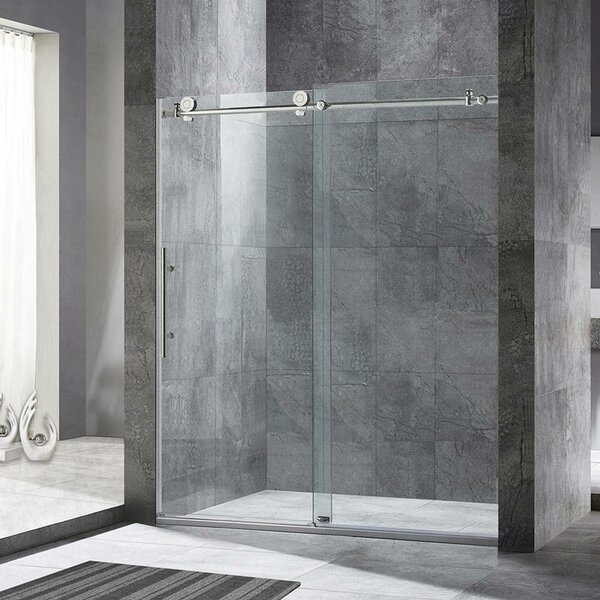Showers usually fall under three types and the shower door you select mainly depends on the style. There are bathtub showers, walk-in enclosures located in a corner and alcove stand-alone stalls.
A 4th type, barrier-free showers, is a subset of alcove showers or corner showers. This type of installation has a doorless style with a modern look. It can also supply a seamless entry to improve availability for wheelchairs.
In addition to the type of shower enclosure you have, you'll need to think about the restroom's layout, the dimensions of the opening and the readily available space around the shower to determine the instructions in which the door opens.
Bypass or Sliding Doors
Bypass or moving shower doors are a common solution for a little restroom or bath tub showers.
- Consist of two and in some cases 3 panels that move along each other on tracks
- Sliding door operation requires no floor space for opening door
- Ideal for broad openings, with a normal opening of 60-inches wide
- Some models are developed for alcove walk-in showers
Pivot or Hinged Doors
Hinged shower doors swing open from a single side on corner or alcove walk-ins.
- Ideal for openings that are too narrow to accommodate a bypass door
- Can be integrated with inline fixed panels in large alcove enclosures
- Some designs have hinges to allow door to swing both inward and outside
Round Doors
Round shower doors are a space-saving choice for corner walk-in shower stalls.
- Ideal for corner standalone showers
- Often reversible for ideal or left gain access to
- Open by slider or design can have a bypass operation or hinged opening
- Curved glass style reduces the shower's footprint in the bathroom
- Attached to the top and bottom of the frame for stability and smooth operation
Neo-Angle Doors
Neo-angle doors are developed to fit neo-angle shower enclosures for corner setups.
- Take up less flooring area than a rectangular shape style
- Some models have reversible doors for left or right entry
Barrier-Free
Barrier-free showers have a fixed door panel near the shower head.
- Fixed door panel shields spray from the bathroom floor, however no visit door at the opposite end
- Design can make a restroom feel larger and modern
- Opening is often broader than conventional shower doors, offering much easier gain access to for those who need it
Dimensions and Measuring
Accurate measuring is important to make sure a correct suitable for your shower door.
Most new shower doors can be changed somewhat to fit a range of openings and accommodate walls that aren't perfectly square. Even so, the door you select ought to extremely closely match both the width and height of your shower's opening.
Tip: If the enclosure area is new, do not take any measurements up until the shower is complete and the walls are completed. Product on the wall, such as backerboard and tile, can lower the wall-to-wall width by as much as 1-inch on each side.

Follow these actions for accurate measuring:
- Measure the opening width. Figure out the distance from wall to wall at the top and bottom of the opening. The measurements need to be to the closest 1/16- inch. If these vary, select a door utilizing the larger width for a bypass door or the smaller width for a pivot door.
- Measure the opening height. Figure out the distance from the top of the tub edge or shower base to the top of the wall system or tile wall where you want the door to be situated. Procedure vertically at both sides. The measurement ought to be to the nearby 1/16-inch. Select a door with a height less than or equal to the smallest of these measurements.
Idea: Single panel doors are rarely larger than 36-inches broad. For larger openings, set a door with a fixed inline panel.
If you are considering a hinged door, make sure that the door has space to swing open without hitting any obstructions. Extend a measuring tape to the width of the door. Hold one end of the tape where the door hinge will be located and pivot the other end to guarantee there is clearance for opening.
Frame Design
Shower doors are framed or frameless.
Framed doors
- Have aluminum, stainless-steel or composite product framing the glass panel
- Include a track that collects and traps water, requiring regular cleansing
- Framed pivot shower doors just open outward
- A variety of surfaces are available to match your decoration
Frameless doors
- Have a newer design style with through-the-glass mounted hardware and different densities of glass
- Easier to keep tidy
- Create a sensation of spaciousness
- Frameless pivot doors often can open in or out
Glass
The thickness of the glass in your shower door is dependent on structural and style aspects, such as whether the door is framed or frameless. Glass thickness isn't an issue for framed doors since the glass is protected in a metal frame. Usually, the thicker and much heavier the glass is, the more steady and smoother gliding the door will be.
Clear glass shower doors showcase tile and stonework in the shower and can make the small space of your bathroom feel bigger.
Frosted, textured or patterned glass shower doors use differing levels of personal privacy and can include a stylish element to the bathroom.
Pacific Mirror & Glass LLC is Kauai's Glass Shop for Mirrors, Shower Enclosures, Storefront Glass, Glass Railings, Sliding Patio Doors and more.
For more information contact:
Pacific Mirror & Glass LLC
5675 Kawaihau Rd Ste B2
Kapaa, HI 96746
(808) 635-9696
https://www.pacificmirrorandglass.com/